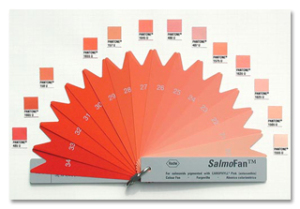
You’ve probably heard about the nutritional value of wild salmon.
But did you know that most salmon today is farmed?
Instead of the pristine Alaskan wilderness, nearly ALL of today’s salmon are raised in cramped, overcrowded salmon farms.
It’s very sad, but true.
And this greatly impacts the nutritional value of the salmon.
But there’s more…
Because farmed salmon can’t move much and their diet consists entirely of aquarium pellets, it arrives at the market a dull, GRAY color.
YUCK!
So scientists have discovered a way to recapture that gorgeous salmon color.
How do they do it?
This may shock you, but 95 percent of Atlantic salmon is DYED with food pellets infused with coloring agents developed by the pharmaceutical giant Hoffman-La Roche.
Colors are selected according to the color fan I’ve posted here, known as the SalmoFan.
I don’t know about you, but I’m not interested in airbrushed fish…
For real Alaskan wild salmon, I’ve always recommended my favorite mail-order company, Vital Choice.
Additionally, if you’re fortunate to live in a nutritionally-aware city, you’ll have an abundance of wild kosher salmon available at your local Whole Foods Market or other quality health food store or fish market.
Simply ask for wild-caught salmon certified by the Marine Stewardship Council, which is what I buy personally for my family.
It’s sold as whole fillets in kosher-certified shrink wrap – and it’s always in the freezer.
Yes, it’s a bit pricey (about $20 per pound). But would you rather spend hundreds of dollars every year on fish oil DHA supplements that are of poor quality, and in most cases terribly rancid?
Not me!
I’d rather enjoy the real deal!
And my family absolutely LOVES top-quality salmon – even the toddlers…
It’s so simple to prepare – and as I always say, the simpler the better!
So when I’m in a rush, I’ll simply poach a whole salmon fillet with fresh lemon juice an sea salt, and serve it to my family with homemade tarter sauce. You can add herbs and spices, or switch out the tarter for marinara.
Use your imagination, and most importantly – ENJOY!
P.S. Don’t overcook your salmon, or many of the vital antioxidants will be destroyed!



